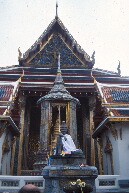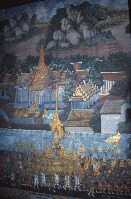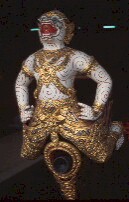BETTER IN BANGKOK Part 2 of 4
by Louis BignamiThey are unlike anything in the world . . . It makes you laugh with delight to think that anything so fantastic could exist on this sober earth . . . They open roads down which the imagination can take many a careless and unexpected journey. Somerset Maughan On Bangkok's temples
All roads lead to where the once walled island capital lurked inside its river bend and defensive klongs, or canals such as Ong Ang and Bang Lamphu. The best Wats, the National Museum, the Grand Palace and more culture than you can buff in a week lurk here with three of the six ¡§first class¡¨ Buddhist temples in Thailand where there are over 30,000 temples in all. Dates are easy. Rama I, the first of the Chakri Kings, built his new capital here on man-made Rattanakosin Island after the destruction of the old capital, Ayutthaya in 1776, a date of certain importance in the United States as well.

Bangkok temple
photo credit: Louis Bignami
Everythng opens at 8 am, but early risers might include a visit to the Golden Mount and Wat Saket to enjoy decent views of Bangkok before smog sets in. You can¡¦t get there too soon. Monks rise early, collect their food and eat nothing after 11 o¡¦clock!
Wat Suthat with its classic buildings, wonderful murals, and statues of Western soldiers and seamen imported as ballast from China offers an alternative jumpstart for the fit and frisky. The Thais considered these last statues ugly enough to scare away evil spirits, for demons in Thai and Indonesian cultures had white faces and copious facial hair.
Nearby, the famous Giant swing, Sao Chin Cha, once supported Bangkok dentists by swinging teams of royals high enough to try to catch money sacks hung at the top of 70 foot poles in their teeth. It's no longer in use.
WAT PO or PHO
Early birds can wing south to the river and turn upstream (to the right) to Wat Po AKA, Wat Phra Chetupon Wimolmangkalaram, the biggest temple in Thailand (20 baht admission; open 8 to 5 daily). Major Thai works of literature, astrology, medicine lurk here, and Wat Pho is the best introduction the island. It¡¦s close to the Grand Palace complex and a short walk from Tha Tien or Tha Chang Piers (good inexpensive food) for those who ferry in. Across the river, the photogenic 343 foot tall Prang, or golden central tower, of Wat Arum, the "Temple of Dawn¨ that, following the "nothing is as it seems" rule, is best seen at dusk, waits tomorrow's visit.
 Start Wat Po with a visit to the gold leafed, 150 foot long Buddha -- don't miss the mother of pearl inlaid feet -- which reclines in the best Bot, or Buddha enclosing open building with its traditional stepped roof, in Bangkok. Check the four huge Stupas and the wonderful stone figures of hermits demonstrating massage and medical techniques.
Start Wat Po with a visit to the gold leafed, 150 foot long Buddha -- don't miss the mother of pearl inlaid feet -- which reclines in the best Bot, or Buddha enclosing open building with its traditional stepped roof, in Bangkok. Check the four huge Stupas and the wonderful stone figures of hermits demonstrating massage and medical techniques.
Then head back away from tourists near the entrance past the Bodhi Tree and two nifty Chinese pavilions to the Library Rama I built in a classic Chinese-style garden. The polychrome decorated conical Chedis, or stupas of the Four Kings offer colorful highlights.
A diverting mish-mash of astrologers, palmists, snake charmers, amulet vendors and much else lurk in and around Wat Po and its School for Traditional Medicine that also teaches Thai massage. It's only $3 an hour for rubdowns when the hotels might charge $30 or more. So, consider a possible return after you and your feet wear down and you need the best foot rubs in the world. You can even take a ten day, 30 hour Thai message course here.
If you start early when the Wat opens and invest an hour here -- last time we spend a day -- and you can get into the Grand Palace before it closes for lunch from 11:30 to 1. Otherwise take a lunch break upstream (right) at Tha Chang Pier food stalls in the cooling river breeze, or graze among stands along Pramane Ground which offer delicious grilled squid and chicken. Adjoining streets jammed with small restaurants, the University and the National Museum serve inexpensive food too. For something a bit more upscale, try the restaurants on both sides of the Krun Thon Bridge.
Health Tip: fruit you can peel and fish or meat that you know is fresh before it's cooked helps prevent upsets. Drink lots of bottled water and use it to brush your teeth too.
After lunch and a cool drink, stroll under the shade trees around Pramane Ground also called Sanum Luang, or Royal Field. This huge open field is the site of royal cremations, King¡¦s Birthday and New Year Festivals. In season you find wonderful team kite fights, three flavors of takraw foot juggling, book fairs, the May Plowing Ceremony that signifies the start of rice planting, kick boxers, soccer players and a lot more. It separates the Grand Palace from Silpakorn University, the National Museum and the Wat Mahathat with meditation classes for foreigners and wildest collection of amulet vendors anywhere in Bangkok.
The Grand Palace
Over 100 separate buildings and throne halls, in almost as many different architectural modes, crowd the Grand Palace complex (125 baht admission including Wat Phra and more). Everyone has favorites. Mine are the Dusit Maha Prasai Throne Room, the nearby rooms with various thrones and royal regalia like the Great White Umbrella of State, and the Queens handicraft displays.
The rest of the complex features chedis, stupas, and exotic roof eaves stirred in with formal European architecture. Note: you need to be "properly dressed" to be admitted. Shorts, sleeveless shirts or skirts and sandals are prohibited, but some loaner clothing may be available. Tip: if you wear socks, bring an extra pair and change them at noon to improve foot comfort. Tip: tong, but light shirts and pants seem cooler than the usual tourist shorts and such.
The dress code and the reasonable admission price gets you into the best eye candy in the world. Every surface in the Palace and Wat offers murals, gold leaf, odd creatures and so much more. Eyes glaze over after a bit. So focus first on your special interests. For example, the Royal Thai Decorations and Coins Pavilion can eat up hours. Then too, with so much bright gold, it is easy to overlook the more subtle delights such as the many small, cool and shaded Chinese gardens with Quing statues or the murals under cloisters. Happily, you can not overlook the 178 panels of the Thai version of the Indian epic, the Ramayana, on marble slabs here. While you can no longer make rubbings from originals, rubbings from copies make great, and inexpensive, souvenirs.
After all this artistic obstacle course, a break in the gardens around the palace seems in order before your visit to Wat Phra Keo, the highlight Wat of Bangkok. If you tire of art and architecture you can, of course, save Wat Phra and the National Museum to start your third day, and substitute shopping or food in Yaowarat, Bangkok¡¦s unique Chinatown Don't miss the river tomorrow either, and here's a bit of "eye candy" from the Royal Barge Museum to encourage
